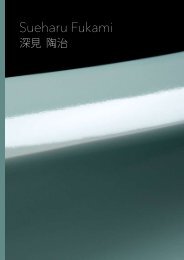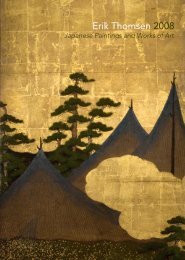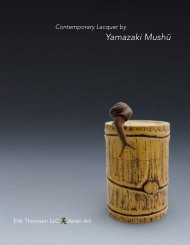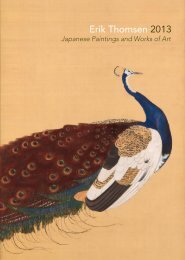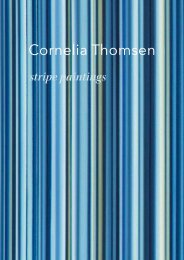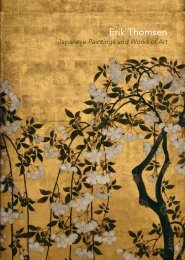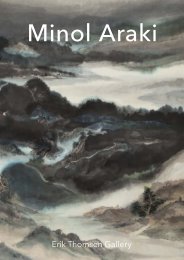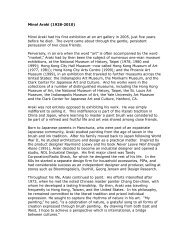View publication (pdf file 6.5 mb) - Erik Thomsen
View publication (pdf file 6.5 mb) - Erik Thomsen
View publication (pdf file 6.5 mb) - Erik Thomsen
- No tags were found...
You also want an ePaper? Increase the reach of your titles
YUMPU automatically turns print PDFs into web optimized ePapers that Google loves.
2Tosa Mitsuyoshi 土 佐 光 吉 (1539 –1613), attr.Scenes from the Tales of GenjiMomoyama Period (1568 –1615), early 17th CH 63 ½" × W 146 ½"(161.3 cm × 372.3 cm)Six-panel folding screenInk, mineral colors, gofun, silver, goldand gold leaf on paperThis important screen displays an elaborate selectionof scenes from the eleventh-century novelTales of Genji. The finely detailed figures interspersedthroughout the composition illustratescenes from different chapters of Genji, but areunified by the theme of nature, more specifically,the link between nature and the protagonists ofthe novel. Two keys to the connections are the fullmoon on the upper left and the bridge on theupper right of the screen.The full moon on the upper left refers to the romanticboat scene on a winter night in the Ukifunechapter, seen in the upper center. Here Niou isseated in the boat with Ukifune and, while lookingat the hills bathed in moon light, they pledgeundying love to each other. 1In the Asagao chapter the moon appears again asGenji and Asagao look out at the garden on a winternight and admire the fallen snow. Genji asks thepage girls to go out in the garden and roll a snowball,and he and Asagao enjoy the scene bathed inmoonlight. 2The moon connects these two scenes, which alsoshare the same season and the nocturnal setting.Central to both cases is the joy of love when lookingat nature together, specifically on a winter night.The bridge in the upper right corner refers to theUkifune love boat scene, which takes place closeto Uji Bridge. 3 The bridge is also associated with theexcursion to Sumiyoshi Shrine in the Miotsukushichapter, seen on the right. Waiting inside his carriage,Genji wants to write a love letter and his servantKoremitsu hands him a writing box and brushes. 4The curved bridge on the screen refers to bothscenes, the Uji Bridge and the Sumiyoshi Bridge;the red torii gate in front of the bridge refers tothe Sumiyoshi Shrine. Bridges with their many poeticallusions became sy<strong>mb</strong>ols for travel in naturein the literal and visual culture of the Heian andlater period. 5The last two scenes that balance the compositionon the bottom left and right corners are, on thebottom left, the emperor being presented withpheasants taken in a hunt, bringing nature to thepalace; 6 and, on the bottom right, the poignantscene from the Yomogiu chapter where PrinceGenji visits his long-lost love, the Safflower Princess,who suffers from poverty in a run-down mansion.Here Prince Genji is led by his servant Koremitsu,who guides him to the dilapidated housethrough the overgrown garden. 7In all of these scenes, we see how the figures negotiatewith nature and how nature relates to love,to imperial offerings, to travel and even to poverty.What at first seems to be a set of non-connectedscenes are in fact expertly selected moments in thenovel that connect by themes from across the panelsof the screen.The screen is attributed to Tosa Mitsuyoshi throughsimilarities in style, facial features, and goldenclouds. The golden clouds are made of two typesof gold—gold leaf bordered with gold wash ongofun—and the features of the faces are superblyexpressive. Mitsuyoshi and his atelier painted anu<strong>mb</strong>er of Genji screens during his lifetime andexamples by him exist in the Metropolitan Museumof Art in New York, the Honolulu Academy of Arts,the Kyoto National Museum and the IdemitsuMuseum of Art.12 13



